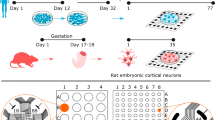Abstract
In a previous study, we assessed the synchronous neural interactions (SNI) in a developing neural network in brain cultures on multielectrode arrays (Christopoulos et al. in J Neural Eng 9:046008, 2012). Here, we report on the effects of apolipoprotein E4 (apoE4) on these neural interactions. We carried out six experiments (five using rodent brain cultures and one using neuroblastoma cultures) in which we recorded local field potentials (LFP) from 59 sites for several days in vitro under the following conditions. In one experiment, we added to the culture media triglyceride (TG)-rich lipoproteins from a human subject with the apoE4/4 genotype, whereas in the other experiments, we added recombinant human apoE4. We found that SNI in the apoE4-treated cultures had higher coefficient of SNI variation, as compared to control cultures. These findings further document the role of SNI as a fundamental aspect of the dynamic organization of neural networks (Langheim et al. in Proc Natl Acad Sci USA 103:455–459, 2006. doi:10.1073/pnas.0509623102; Georgopoulos et al. in J Neural Eng 4:349–355, 2007) and extend the effect of apoE4 on SNI (Leuthold et al. in Exp Brain Res 226:525–536, 2013) across different brain species (human, rodents), apoE source (TG-rich lipoproteins, recombinant), neural signals (MEG, LFP), and brain network (intact brain, developing brain in vitro). To our knowledge, this is the first study of the effects of apoE4 on neural network function in vitro.





Similar content being viewed by others
References
Box GEP, Jenkins GW (1970) Time series analysis: forecasting and control. Holden Day, San Francisco
Christopoulos VN, Boeff DV, Evans CD, Crowe DA, Amirikian B, Georgopoulos A, Georgopoulos AP (2012) A network analysis of developing brain cultures. J Neural Eng 9:046008
Georgopoulos A, Kafonek SD, Raikhel I (1994) Diabetic postprandial triglyceride-rich lipoproteins increase esterified cholesterol accumulation in THP-1 macrophages. Metabolism 43:1063–1072
Georgopoulos AP et al (2007) Synchronous neural interactions assessed by magnetoencephalography: a functional biomarker for brain disorders. J Neural Eng 4:349–355
Høgh P et al (2000) Apoliprotein E and multiple sclerosis: impact of the epsilon-4 allele on susceptibility, clinical type and progression rate. Mult Scler 6:226–230
Langheim FJ, Leuthold AC, Georgopoulos AP (2006) Synchronous dynamic brain networks revealed by magnetoencephalography. Proc Natl Acad Sci USA 103:455–459. doi:10.1073/pnas.0509623102
Leuthold AC, Mahan MY, Stanwyck JJ, Georgopoulos A, Georgopoulos AP (2013) The number of cysteine residues per mole in apolipoprotein E affects systematically synchronous neural interactions in women’s healthy brains. Exp Brain Res 226:525–536. doi:10.1007/s00221-013-3464-x
Lindgren FT, Jensen LC, Wills RD, Stevens GR (1972) Subfractionation of Sf 4–105, Sf 4–20 and high density lipoproteins. Lipids 7:194–201
MacNabb C, Georgopoulos A, Georgopoulos AP (1998) Effects of thyroid hormone and apolipoprotein E on growth and differentiation of neuroblastoma cells. Soc Neurosci Abstr 24:1296
Mahley RW, Huang Y (2012a) Apolipoprotein E sets the stage: response to injury triggers neuropathology. Neuron 76:871–885. doi:10.1016/j.neuron.2012.11.020
Mahley RW, Huang Y (2012b) Small-molecule structure correctors target abnormal protein structure and function: structure corrector rescue of apolipoprotein E4-associated neuropathology. J Med Chem 55:8997–9008. doi:10.1021/jm3008618
Nalbantoglu J, Gilfix BM, Bertrand P, Robitaille Y, Gauthier S, Rosenblatt DS, Poirier J (1994) Predictive value of apolipoprotein E genotyping in Alzheimer’s disease: results of an autopsy series and an analysis of several combined studies. Ann Neurol 36:889–895
Nathan BP et al (1994) Differential effects of apolipoproteins E3 and E4 on neuronal growth in vitro. Science 264:850–852
Peterson CK, James LM, Anders SL, Engdahl PE, Georgopoulos AP (2015) The number of cysteine residues per mole in apolipoprotein E is associated with the severity of PTSD re-experiencing symptoms. J Neuropsychiatry Clin Neurosci appineuropsych13090205 [Epub ahead of print]
Prasher VP, Chowdhury TA, Rowe BR, Bain SC (1997) ApoE genotype and Alzheimer’s disease in adults with down syndrome: meta-analysis. Am J Ment Retard 102:103–110
Priestley MB (1981) Spectral analysis and time series. Academic, San Diego
Qiu Z, Crutcher KA, Hyman BT, Rebeck GW (2003) ApoE isoforms affect neuronal N-methyl-d-aspartate calcium responses and toxicity via receptor-mediated processes. Neuroscience 122:291–303
Redgrave TG, Carlson LA (1979) Changes in plasma very low density and low density lipoprotein content, composition and size after a fatty meal in normo and hypertriglyceridemic men. J Lipid Res 20:217–229
Reymer WA, Groenemeyer BE, Van de Burg R (1995) Apolipoprotein E genotyping on agarose gels. Clin Chem 41:1046–1047
Veinbergs I, Everson A, Sagara Y, Masliah E (2002) Neurotoxic effects of apolipoprotein E4 are mediated via dysregulation of calcium homeostasis. J Neurosci Res 67:379–387
Weisgraber KH, Rall SC Jr, Mahley RW (1981) Human E apoprotein heterogeneity cysteine–arginine interchanges in the amino acid sequence of the apo-E isoforms. J Biol Chem 256:9077–9083
Acknowledgments
We thank Dean Evans and Dale Boeff for their valuable assistance with the cultures and recordings, and Laura Kalipe for her assistance with preparing the human apoE4/4 solution. This work was supported by the American Legion Brain Sciences Chair, the University of Minnesota, and the US Department of Veterans Affairs.
Conflict of interest
The authors declare that they have no conflicts of interest.
Ethical standard
The study protocol was approved by the appropriate institutional review board and was performed in accordance with the ethical standards outlined in the Declaration of Helsinki.
Informed consent
The human participant provided written informed consent prior to participating in the study.
Author information
Authors and Affiliations
Corresponding author
Rights and permissions
About this article
Cite this article
Christopoulos, V., Georgopoulos, A. & Georgopoulos, A.P. The effect of apolipoprotein E4 on synchronous neural interactions in brain cultures. Exp Brain Res 233, 1977–1982 (2015). https://doi.org/10.1007/s00221-015-4270-4
Received:
Accepted:
Published:
Issue Date:
DOI: https://doi.org/10.1007/s00221-015-4270-4




